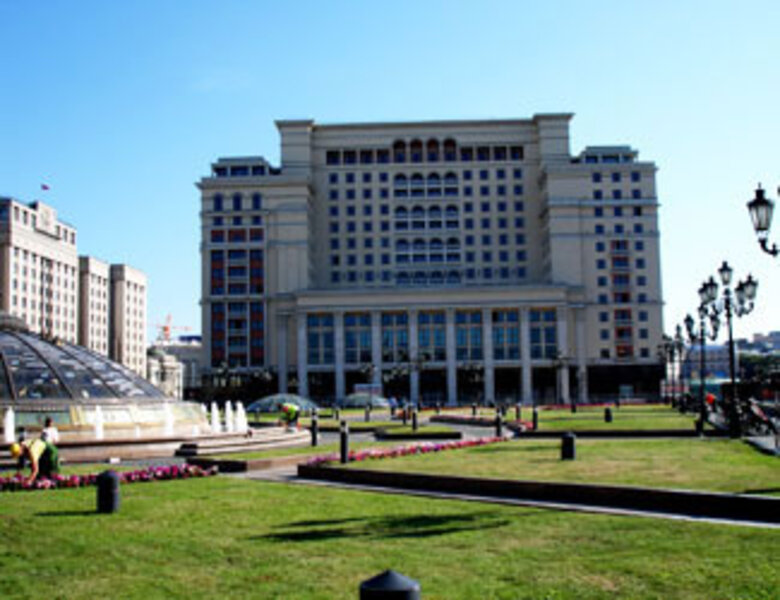Moscow preservationists see silver lining in economic slump
Loading...
| Moscow
Once-bustling construction sites around Moscow have fallen silent since the financial crisis hit and the city's real estate bubble burst last fall. Most people shudder at the sight of the crane-topped skeletons of unfinished skyscrapers – reminders of an economic disaster that is still spreading.
But some prominent Muscovites see a silver lining. They say the city has gotten a second chance to halt the breakneck destruction of its historic center, and replace the anything-goes building splurge of recent years with a plan to preserve Moscow's architectural heritage.
"During the past 15 years we've lost our Moscow," says David Sarkisyan, director of the Shchusev State Museum of Architecture in Moscow. "Something like 600 buildings, key pieces of the city's architectural cocktail, have been ruined, and 300 more are under threat. But, strange to say, the crisis is helping. All the city's main developers are bankrupt, and the bulldozers have been stilled for the time being."
The extent of Moscow's helter-skelter transformation in recent years has been documented in a huge study published this summer by the Moscow Architectural Preservation Society (MAPS), a group founded five years ago by foreign journalists that has since expanded to include dozens of architects, historians, tour guides, and other Moscow-lovers. The report decries Mayor Yury Luzhkov's profit-driven strategy of allowing developers to rip apart famous old buildings and replace them with "sham replicas" – which have underground parking and modern amenities – as a "theme park approach to an historic city."
"There is no other capital in peacetime Europe that is being subjected to such devastation for the sake of earning a fast megabuck," the study said.
Critics blame Mr. Luzhkov – whose billionaire wife, Yelena Baturina, is one of the city's main real estate developers – for allowing a property boom to sweep aside restraint.
"In Moscow's center, only 5 percent of historic structures are still intact," says Irina Korobyina, director of the independent Modern Architecture Center and member of Moscow's advisory city-planning council. "The authorities declare their intent is not to do damage, but it's enough to walk around downtown Moscow to see that there are no effective instruments of control and no guarantee that the law will be followed. The only aim of development appears to be to satisfy the greed of developers."
The Moscow mayor's office, citing summer holidays, declined to make an official available for comment.
Many people do seem impressed by the rapid transformation of the city's core, which has modernized its appearance, upgraded facilities, and cleaned away Soviet-era jumble and grime.
Still, many of the changes have altered Moscow's historic center and enraged preservationists, including:
•The Hotel Moskva. The first major Soviet-era hotel, built in the 1930s next-door to the Kremlin, was a hulking Stalinist monument constructed from materials looted by the Bolsheviks from churches and Czarist-era palaces. Torn down by Luzhkov in 2004, it has been replaced by a "replica" that's set to open as a five-star hotel. "Of course, you couldn't love the Moskva for what it was," says Kevin O'Flynn, one of the original founders of MAPS. "But it was a building of its time and it made sense where it was."
•The Manege. The Czarist-era royal stables were turned into an art gallery in Soviet times, and burned down in 2004. The fire, whose causes remain unexplained, forcibly settled a dispute between the Ministry of Culture, which wanted no changes to one of Moscow's most beloved structures, and Luzhkov's planned renovation. A virtual replica was recently unveiled in the place of the original.
•Voyentorg. An Art Nouveau classic built in 1912, and turned into a military department store by the Soviets, it was the first major Moscow landmark demolished by Luzhkov, in 2003. Critics are beside themselves with fury at the high-end shopping mall set to open in its place. "It's a scapegrace, an awful parody of what Voyentorg used to be," says Nikolai Lyzlov, a Moscow architect.
•The Bolshoi Theater, built in 1824, has been draped in tarpaulins and gutted for almost five years and is scheduled to reopen in 2013. In July, its chief conductor, Alexander Vedernikov, quit over the renovations, complaining that "the theater is putting bureaucratic interests above artistic ones."
Amid the pause created by Russia's financial crisis, there is a chance to save not only Moscow's shrinking heritage, but also that of other major cities, such as St. Petersburg, where the bulldozers have barely started work, says Marina Khrustalyova, an architectural historian and a director of MAPS.
"Where Moscow goes, the rest of Russia follows," she says. "We need to attract attention to this issue now, while there's still something left to save."





